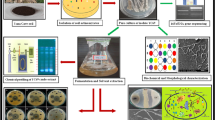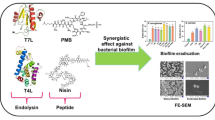Abstract
Parasporins (PS), a class of non-insecticidal and non-hemolytic crystal proteins of Bacillus thuringiensis (Bt), are being explored as promising anti-cancer agents due to their specific toxicity to cancer cells. This work is considered as a first initiative aiming at investigating Algerian soil Bt isolates’ activity and cytotoxic potential against cancer cells. A total of 48 Bacillus spp. were isolated from different sites in Algeria. Phenotypic and biochemical tests, 16S rDNA molecular identification, and microscopic observation of crystal have confirmed the identification of Bt for ten strains. A screening for non-hemolytic crystalline proteins was performed. Extraction, purification, and activation of non-hemolytic proteins by chromatographic analysis yielded several polypeptides of different molecular weights. A purified PS1, with pro-protein of 81 kDa and several peptides with different molecular weights (18–58 kDa) after activation by trypsin, has been identified from the strain BDzG. The NH2-terminal sequence deciphered in BLAST analysis showed homology to a Bt PS1 protein. Moreover, the screening of parasporin-1 (PS1) gene has also been performed. Cytocidal activity against human epithelial type 2 (HEp2) cells, considered to originate from a human laryngeal carcinoma, was observed with an IC50 equal to 2.33 μg/ml, while moderate cytotoxicity against adenocarcinomic human alveolar basal epithelial (A549) cells has been shown with IC50 equal to 18.54 μg/ml. No cytotoxicity against normal cells was noted. Fluorescence microscopy revealed a condensed or fragmented chromatin indicating the apoptotic death of HEp2 cells. Thus, Bt PS-producer isolated from Algerian soil might have a potential to join the arsenal of natural anti-cancer drugs with high therapeutic potential.






Similar content being viewed by others
References
International Agency for Research on Cancer (CIRC/OMS2018) (2018) Le fardeau du cancer atteint 18,1 millions de nouveaux cas et 9,6 millions de décès par cancer en 2018. Communiqué de presse n°263. https://www.iarc.fr/wpcontent/uploads/2018/09/pr263_F.pdf. Accessed 12 Sept 2018
Abderrahmani A, Tapi A, Nateche F, Chollet M, Leclère V, Wathelet B, Hacene H, Jacques P (2011) Bioinformatics and molecular approaches to detect NRPS genes; involved in the biosynthesis of kurstakin from Bacillus thuringiensis. Appl Microbiol Biotechnol 92(3):571–581. https://doi.org/10.1007/s00253-011-3453-6
Ferdous UT, Shishir MA, Khan SN, Hoq MM (2018) Bacillus spp: attractive sources of anti-cancer and anti-proliferative biomolecules. Microb Bioact 1(1):033–045. https://doi.org/10.25163/microbbioacts.11005B0408130818
Djenane Z, Nateche F, Ameziane M, Gomis-Cebolla J, El-Aichar F, Khorf H, Ferré J (2017) Assessment of the antimicrobial activity and the entomocidal potential of Bacillus thuringiensis isolates from Algeria. Toxins 9(4):139. https://doi.org/10.3390/toxins9040139
Uemori A, Ohgushi A, Yasuteke K, Maeda M, Misuki E, Ohba M (2008) Parasporin-1Ab, a novel Bacillus thuringiensis cytotoxin preferentially active on human cells in vitro. Anticancer Res 28:91–96
Mizuki E, Ohba M, Akao T, Yamashita S, Saitoh H, Park YS (1999) Unique activity associated with non-insecticidal Bacillus thuringiensis parasporal inclusions: in vitro cell-killing action on human cancer cells. J Appl Microbiol 86(3):477–486. https://doi.org/10.1046/j.1365-2672.1999.00692.x
Jung YC, Mizuki E, Akao T, Cote JC (2007) Isolation and characterization of a novel Bacillus thuringiensis strain expressing a novel crystal protein with cytocidal activity against human cancer cells. J Appl Microbiol 103(1):65–79. https://doi.org/10.1111/j.1365-2672.2006.03260.x
Mizuki E, Park YS, Saitoh H, Yamashita S, Akao T, Higuchi K, Ohba M (2000) Parasporin, a human leukemic cell-recognizing parasporal protein of Bacillus thuringiensis. Clin Diagn Lab Immunol 7(4):624–634. https://doi.org/10.1128/CDLI.7.4.625-634.2000
Ohba M, Mizuki E, Uemori A (2009) Parasporin, a new anticancer protein group from Bacillus thuringiensis. Anticancer Res 29(1):427–433
Yasutake K, Binh ND, Kagoshima K, Uemori A, Ohgushi A, Maeda M, Mizuki E, Yu YM (2006) Occurrence of parasporin-producing Bacillus thuringiensis in Vietnam. Can J Microbiol 52(4):365–372. https://doi.org/10.1139/w05-134
Moazamian E, Bahador N, Azapira N, Rasouli M (2018) Anti-cancer parasporin toxins of new Bacillus thuringiensis against Human colon (HCT-116) and blood (CCRF-CEM) cancer cell lines. Curr Microbiol 75(8):1090–1098. https://doi.org/10.10007/s00284-018-1479-z
Ishii T, Ohba M (1993) Diversity of Bacillus thuringiensis environmental isolates showing larvicidal activity specific for mosquitoes. J Gen Microbiol 139(11):2849–2854. https://doi.org/10.1099/00221287-139-11-2849
Abirami P, Poornima K, Suguna P, Saranya V, Selvanayagam P, Shenbagarathai R (2016) Phenotypic characterization of indigenous Bacillus thuringiensis strain (BT LDC 501) expressing cancer cell killing protein. J Exp Biol Agric Sci 4(2):232–241
Abirami P, Poornima K, Binuramesh C, Suguna P, Saranya V, Selvanayagam P, Shenbagarathai R (2016) Screening and characterization of a non-insecticidal Bacillus thuringiensis strain producing parasporal protein with selective toxicity against human colon cancer cell lines. Ann Microbiol 66(3):1167–1178. https://doi.org/10.1007/s13213-016-1204-8
Brasseur K, Auger P, Asselin E, Parent S, Coté JC, Sirois M (2015) Parasporin-2 from a new Bacillus thuringiensis 4R2 strain induces caspaces activation and apoptosis in human cancer cells. PLoS ONE 10(8):e0135106. https://doi.org/10.1371/journal.pone.0135106
Kim HS, Yamasashita S, Akao T, Saitoh H, Higuchi K, Park YS, Mizuki E, Ohba M (2000) In vitro cytotoxicity of non-cyt inclusion proteins of a Bacillus thuringiensis isolate against human cells, including cancer cells. J Appl Microbiol 89(1):16–23. https://doi.org/10.1046/j.1365-2672.2000.01087.x
Lenina NK, Naveenkumar A, Sozhavendan AE, Balakrishnan N, Balasubramani V, Udayasuriyan V (2014) Characterization of parasporin gene harboring Indian isolates of Bacillus thuringiensis. 3 Biotech 4(5):545–551. https://doi.org/10.1007/s13205-013-0190-9
Aboul-Soud Mourad MAM, Al-Amri MZ, Kumar A, Al-Sheikh YA, Ashour AE, El-Kersh TA (2019) Specific cytotoxic effects of parasporal crystal proteins isolated from native Saudi Arabian Bacillus thuringiensis strains against cervical cancer cells. Molecules 24:506. https://doi.org/10.3390/molecules24030506
Katayama H, Yokota H, Akao T, Nakamura O, Ohba M, Mekada E, Mizuki E (2005) Parasporin-1, a novel cytotoxic protein to Human cells from non-insecticidal parasporal inclusion of Bacillus thuringiensis. J Biochem 137:17–25. https://doi.org/10.1093/jb/mvi003
Katayama H, Kusaka Y, Yokota H, Akao T, Kojima M, Nakamura O, Mekada E, Mizuki E (2007) Parasporin-1 a novel cytotoxic protein from Bacillus thuringiensis, unduces Ca2+ influx and a sustained elevation of the cytoplasmic Ca2+ concentration in toxin-sensitive cells. J Biol Chem 282(10):7742–7752. https://doi.org/10.1074/jbc.M611382200
Kuroda S, Begum A, Saga M, Hirao A, Mizuki E, Sakai H, Hayakawa T (2013) Parasporin 1Ac2, a novel cytotoxic crystal protein isolated from Bacillus thuringiensis B0462 strain. Curr Microbiol 66(5):475–480. https://doi.org/10.1007/s00284-013-0301-1
Wong SYR (2010) Bacillus thuringiensis parasporal proteins and their effect on human cancer cells: on overview. leJSME 4(2):3–9
Ito A, Sasaguri Y, Kitada S, Kusaka Y, Kuwano K, Masutomi K, Misuki E, Akao T, Ohba M (2004) A Bacillus thuringiensis crystal protein with selective cytocidal action to human cells. J Biol Chem 279(20):21282–21286. https://doi.org/10.1074/jbc.M401881200
Kitada S, Abe Y, Shimada H, Kusada Y, Matsuoy Y, Katayama H, Okumura S, Akao T, Mizuki E, Kuge O, Sasaguri Y, Ohba M, Ito A (2006) Cytocidal action of parasporin-2, an anti-tumor crystal toxin from Bacillus thuringiensis. J Biol Chem 281:26350–26360. https://doi.org/10.1074/jbc.M602589200
Oktay MK, Şahin B, Güneş H (2018) Characterization of native Bacillus thuringiensis strains for cytotoxicity against human cancer cell lines. J Environ Biol 39:958–965
Yamashita S, Katayama H, Saitoh H, Akao T, Park YS, Mizuki E et al (2005) Typical three-domain Cry proteins of Bacillus thuringiensis strain A1462 exhibit cytocidal activity on limited human cancer cells. J Biochem 138(6):663–672. https://doi.org/10.1093/jb/mvi177
Okumura S, Saitoh H, Ishikawa T, Inouye K, Mizuki E (2011) Mode of action of parasporin-4, a cytocidal protein from Bacillus thuringiensis. Biochem Biophys Acta 1808(6):1476–1482. https://doi.org/10.1016/J.bbamem.2010.11.003
Ekino K, Okumura S, Ishikawa T, Kitada S, Saitoh H, Akao T, Oka T, Nomura Y, Ohba M, Shin T, Mizuki E (2014) Cloning and characterization of a unique cytotoxic protein parasporin-5 produced by Bacillus thuringiensis A1100 strain. Toxins 6(6):1882–1895. https://doi.org/10.3390/toxins6061882
Nagamatsu Y, Okamura S, Saitou H, Akao T, Mizuki E (2010) Three Cry toxins in two types from Bacillus thuringiensis strain M019 preferentially kill human hepatocyte cancer and uterus. Biosci Biotechnol Mol Biochem 74(3):494–498. https://doi.org/10.1271/bbb.90615
Rahbani MJ, Salameh D, Kallassy AM, Chamy L, Brandam C, Lteif R (2014) A simple method for the separation of Bacillus thuringiensis spores and crystals. J Microbiol Methods 107:147–149. https://doi.org/10.1016/j.mimet.2014.10.003
Martin PAW, Travers RS (1989) Worldwide abundance and distribution of Bacillus thuringiensis isolates. Appl Environ Microbiol 55(10):2437–2442
Lane DJ (1991) 16S/23S rRNA sequencing. In: Stackebrandt E, Goodfellow M (eds) Nucleic acid techniques in bacterial systematic. Wiley, New York, pp 115–175
Sambrook J, Fritsch E, Maniatis T (1989) Molecular cloning: a laboratory manual, 2nd edn. Cold Spring Harbor Laboratory Press, Cold Spring Harbor, pp 23–38
Nadarajah VD, TingD Chan KK, Mohamed SM, Kanakeswary K, Lee HL (2008) Selective cytotoxic activity against leukemic cell lines from mosquitocidal Bacillus thuringiensis parasporal inclusions. South East Asian J Trop Med Public Health 39(2):235–245. https://doi.org/10.3390/molecules24030506
Bradford MM (1976) A rapid and sensitive method for the quantitation of microgram quantities of protein utilizing the principle of protein-dye binding. Anal Biochem 72(1,2):248–254. https://doi.org/10.1006/abio.1976.9999
Laemmli UK (1970) Cleavage of structural proteins during the assembly of the head of bacteriophage T4. Nature 227:680–685. https://doi.org/10.1038/227680a0
Barnabe M (2017) Cell viability assays: MTT assay application and protocol. https://blog.quartzy.com/2017/05/01/cell-viability-assays-mtt-protocol. Accessed 1 May 2017
Cho KS, Lee EH, Choi JS, Joo CK (1999) Reactive oxygen species-induced apoptosis and necrosis in bovine corneal endothelial cells. IOVS 40(5):911–919
Attari F, Sepehri H, Delph L, Goliei B (2009) Apoptotic and necrotic effects of pectic acid on rat pituitary GH3/B6 tumor cells. Iran Biomed J 13(4):163–170
Ichikawa M, Uemori A, Ogushi A, Yasutake K (2007) Phenotypic and morphometric characterization of Bacillus thuringiensis parasporin-1 producers: a comparison with insecticidal cry protein producers. J Fac Agric Kyushu Univ 52(2):307–313
Ichikawa M, Uemori A, Yasutake K, Kagoshima K, Mizukin E, Ohba M (2008) Failure to phenotypically discriminate between non-insecticidal Bacillus thuringiensis strains with anticancer parasporins (PS2, PS3, and PS4) and Bacillus thuringiensis strains that produce insecticidal cry proteins. Appl Entomol Zool 43(3):421–426. https://doi.org/10.1303/aez.2008.421
Logan NA, Carman JA, Melling J, Berkeley RCW (1985) Identification of Bacillus anthracis by API tests. J Med Microbiol 20(1):75–85. https://doi.org/10.1099/00222615-20-1-75
Logan NA, Berkeley RCW (1984) Identification of Bacillus strains using API system. J Gen Microbiol 130(7):1871–1882
Tamura K, Stecher G, Peterson D, Filipski A, Kumar S (2013) MEGA6: molecular evolutionary genetics analysis version 6.0. Mol Biol Evol 30(12):2725–2729. https://doi.org/10.1093/molbev/mst197
Tamura K, Nei M (1993) Estimation of the number of nucleotide substitutions in the control region of mitochondrial DNA in humans and chimpanzees. Mol Biol Evol 10(3):512–526. https://doi.org/10.1093/oxfordjournals.molbev.a040023
Chubicka T, Girija D, Deepa K, Salini D, Meera N, Raghavamenon AC, Divya MK, Babu TDA (2018) Parasporin from Bacillus thuringiensis native to Peninsular India induces apoptosis in cancer cells through intrinsic pathway. J Biosci 43(2):407–416. https://doi.org/10.1007/s12038-018-9759-0
Acknowledgements
The authors would like to express their thanks and gratitude to Mr. A. Adjerad for the statistical part assistance. Special thanks are also due to Mr. A.S. Moulla for constructively proofreading and language polishing services. This work is part of a Doctoral Thesis in Environmental Engineering by Mrs Lila Aberkane at the National Polytechnic School of Algiers (ENP, Algeria).
Funding
This study was financially supported by Nuclear Research Center of Algiers (CRNA). The funding entity had no contribution in the study design and data collection, analysis, and interpretation as well as the manuscript writing.
Author information
Authors and Affiliations
Corresponding author
Ethics declarations
Conflict of interest
The authors declare that they have no conflict of interest.
Ethical Approval
Ethical clearance and approval for the study was obtained from the Ethical Committee in Human Clinical Research [Mustapha PACHA University Hospital Centre of Algiers (CHUMA) and Pasteur Institute of Algiers (IPA), Algeria].
Additional information
Publisher's Note
Springer Nature remains neutral with regard to jurisdictional claims in published maps and institutional affiliations.
Electronic supplementary material
Below is the link to the electronic supplementary material.
Rights and permissions
About this article
Cite this article
Aberkane, L., Nacer-Khodja, A., Djenane, Z. et al. In Vitro Cytotoxicity of Parasporins from Native Algerian Bacillus thuringiensis Strains Against Laryngeal and Alveolar Cancers. Curr Microbiol 77, 405–414 (2020). https://doi.org/10.1007/s00284-019-01841-2
Received:
Accepted:
Published:
Issue Date:
DOI: https://doi.org/10.1007/s00284-019-01841-2




